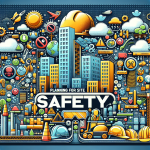The Importance of PPE in Ensuring Workplace Safety
When it comes to ensuring workplace safety, Personal Protective Equipment (PPE) plays a crucial role in protecting workers from potential hazards. From construction sites to healthcare facilities, PPE is essential in safeguarding employees and preventing accidents. In this article, we will delve into the significance of PPE and why it should be a top priority in every workplace.
Understanding the Role of PPE
PPE encompasses a range of protective gear designed to minimize exposure to various hazards. This can include items such as helmets, gloves, goggles, masks, and more. The primary goal of PPE is to create a barrier between the worker and potential dangers, reducing the risk of injury or illness.
The Impact of PPE on Workplace Safety
By wearing the appropriate PPE, workers can significantly reduce the likelihood of accidents and injuries. For example, in a construction setting, a hard hat can protect against head injuries from falling objects. Similarly, gloves can shield hands from cuts and abrasions, while masks can prevent inhalation of harmful substances.
Compliance with Regulations
Many industries have specific regulations mandating the use of PPE to ensure the safety of workers. Employers are required to provide suitable PPE and enforce its use to maintain a safe working environment. Failure to comply with these regulations can result in fines and penalties.
Choosing the Right PPE
When selecting PPE, it is essential to consider the specific hazards present in the workplace. Different tasks require different types of protective gear, so a thorough assessment of risks is crucial. Additionally, PPE should fit properly and be comfortable to wear to ensure maximum effectiveness.
Training and Education
Proper training on the correct use and maintenance of PPE is vital to ensure its effectiveness. Workers should be educated on when and how to use PPE, as well as how to inspect and care for their gear. Regular training sessions can reinforce the importance of PPE in workplace safety.
Conclusion
In conclusion, Personal Protective Equipment (PPE) is a critical component of workplace safety. By providing employees with the appropriate gear and ensuring compliance with regulations, employers can create a safe working environment and prevent accidents. Prioritizing the use of PPE not only protects workers but also contributes to overall productivity and efficiency.
FAQs
1. What are the common types of PPE used in the workplace?
Common types of PPE include helmets, gloves, goggles, masks, ear protection, and safety vests.
2. Is it the employer’s responsibility to provide PPE?
Yes, employers are responsible for providing suitable PPE to employees free of charge.
3. How often should PPE be inspected?
PPE should be inspected regularly for any signs of damage or wear and tear. It should also be replaced as needed.
4. Can employees refuse to wear PPE?
Employees should not refuse to wear PPE if it is required for their safety. Refusal to comply with PPE regulations can result in disciplinary action.
5. How can employers promote a culture of safety regarding PPE?
Employers can promote a culture of safety by providing proper training, enforcing PPE policies, and encouraging open communication about safety concerns.


